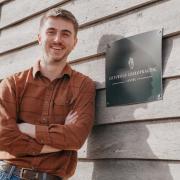Woodland champion and bushcraft expert Ray Mears tells Katie Jarvis that we owe everything to trees.
‘Ray Mears?’ Ed says, happening to glance over my shoulder at an email. ‘You’re interviewing Ray Mears?’
He disappears for a moment before returning with a hefty tome he plonks in front of me: Ray Mears, wild food.
‘I made rosehip tea from that book.’
Suddenly, images flood back. Ed, as a child, devouring Ray’s lessons in bushcraft; building shelters – properly constructed shelters – in local woods. Not only identifying birds from their song but sometimes even telling me what they were doing as they piped. Ed up at 5am to sit, stock-still, watching early-rising wildlife.
‘It wasn’t about adventure,’ he says. ‘Not ‘Chris Ryan’ adrenaline. It was about appreciating where you were; it was about ancestral connection.’
Ed, normally sparing with praise, really wants me to get this.
‘Mum,’ he says, ‘Ray Mears is the reason I studied biology at university.’
‘UNUSUAL, ISN’T IT?’ Ray Mears says.
He’s talking about British Woodland: Discover the Secret World of Our Trees, his latest book, out just last month.
And it is unusual. Yes.

It’s a paean to our much-depleted woodland. A song of praise to the poor, stricken ash that could – if properly coppiced – outlive four centuries; ash, that’s perfect for axes, bows, hockey sticks and bowls. ‘Old-smelling wood’, the Sioux people call it; ‘weapon wood’. Hazel (I’m cherry (-tree) -picking here) that can be twisted and turned into fences and thatching spars. In late summer, unfussy squirrels will be first to gobble the nuts, regardless of ripeness; the next diners at the table will be more discerning jays, nuthatches, woodpigeons and woodpeckers; dormice, fattening up for a long winter snooze. The hornbeam that was used by Romans for bellicose chariots, but that can also turn its back on warfare: its leaves, bound to a wound, can stop the bleeding.
Lime, maple, medlar, oak.
Sea buckthorn, sweet chestnut.
Walnut, wild cherry, yew. (Et al.)
(The very names roll deliciously around my mouth.)
We learn, in this book, to identify these species by drawings of leaves; by their uses; by the flora (picture hairy, toxic dog’s mercury; a purple-flush of dog violet; imagine the pervasive scent of wild garlic) and fauna that nestle in, on, around and underneath.
Every sense.
‘The ash is a very soft sound when the wind blows through,’ Ray Mears says, as we chat. ‘Whereas the dry, leathery leaves of an oak make a much louder sound. Each tree has its own sound.’
At certain times of year, you could identify a forest, blindfolded.
‘If you smell the tannin in oak and the tannin in a piece of sweet chestnut, you can tell them apart immediately; there’s a different fruitiness to one of them. I’ll leave you to explore that…’ he challenges me.
He writes about these differences alongside practical lessons, such as how to make fire. (Perfect woods for drills are those such as elderberry and dog rose; for a hearth, try sycamore or white willow. ‘Concentrate more on generating speed than pressure.’)
He didn’t want simply to write an ABC of trees.
‘I want to awaken people’s interest in trees. And a field guide wouldn’t do the job. You have to want to know before you learn.’
He pauses for a moment to think about it.
‘The great thing about wilderness bushcraft [NB ‘wilderness’; hardcore, genuine bushcraft] is that, when you teach someone about a plant, you don’t just point at it and say its name. You involve people by showing them how to use it, and you get them to do it. Once you’ve used something, you never forget.’
So, yes, this book is unusual.
But, in another way, this book is blindingly, clap-hand-to-forehead-ly obvious.
For he also uses trees to tell the story of human development. For a few pages, I merely mused that this was an interesting take on pre-history. It didn’t take long to realise the two are inseparable.
He nods.
‘If we hadn’t had trees, we wouldn’t have made fire; we wouldn’t have discovered metal. You and I wouldn’t be talking; we wouldn’t be wearing clothes. Everything we take for granted in the world in terms of our technology, we get from our knowledge of trees.’
I mean, doh. Of course; I just hadn’t twigged. (No pun.)
Tools for hunting. Fire for cooking that radically altered our diets and, thus, our brains. Fire – honestly, can’t praise it enough – that helped free us from the prison of night; encouraged communication and community; helped with communication, location, even the binding power-slash-control of religion.
(‘I am sure,’ he writes, at one point, ‘that many of the world’s political problems would be resolved if leaders sat around a campfire – a place of equality where each in turn is tested by the smoke and will feel the need to contribute in the group effort to find firewood.’)
Yet are we grateful?
‘What really irritates me is: one, we don’t recognise that; and two, we just chop them down, willy-nilly. We think, oh, they’re just a tree. Not important.
‘But it is. It’s a living thing and it can live much longer than you or I.
‘And I think we should show more respect to trees.’
How about the councillor (Ray quotes) who said à propos a controversial road development, ‘I don’t know what all the fuss is about. We can plant a new ancient woodland nearby.’
Or a story in the nationals recently about Plymouth cutting down 110 trees under cover of darkness.
‘Unbelievable.’
There was a study, Ray says, based around an American town losing its trees to disease. As trees came down, heart disease went up.
‘In lockdown, we saw how important open areas are. Not far from where I live, there’s a very big area of woodland. And now they’ve put in car-park fees. £6 a day! Somebody saw those cars and thought: We could monetise this. And not only that but, to justify it, they’ve put in paving-slabs around the car park. They’ve urbanised what was a truly rustic and beautiful scene.’
Umm. And I guess NHS fees will go up accordingly if people can’t get to woodland.
‘Ridiculous. Makes my blood boil.’
TIME MACHINE; that’s something wood hasn’t given us yet. But, if Ray Mears could travel into our ancient past – perhaps to see how we interacted with an almost 100-percent wood-cover – which year would he set the dial to?
‘The past is full of mysteries. For me, it would be the Mesolithic, the zenith of our hunting and gathering society, to see how people were living within those forests. To see the materials and the objects made of wood that are lost to us today. Because they depended on the forest in a way we can’t even glimpse at.’

In the book, he draws on his experiences in remote parts of the world – indigenous communities in Australia; the Inuit, Siberian Evenk, the Sami of northern climes; the Hadza of the great baobab forests surrounding Lake Eyasi in northern Tanzania.
Does he feel he’s come close to seeing that kind of Mesolithic oneness with forests?
‘Yes, there have been many times. Meeting Pygmy in the rainforest. [He makes the culturally sensitive point that – whatever outsiders think – they refer to themselves as ‘Pygmy’.] These are people who, if you remove them from the forest, would wither away and die; their spirit dies. They are so much a part of the forest, and it is the most beautiful thing to witness.’
He once spent a day (‘a wonderful day’), looking at their trees and learning how to use different resources in the rainforest. A Bantu tribesman acted as translator.
‘He looked down on the Pygmy; they were lesser beings to him. Yet he had a compass round his neck. They didn’t need it in the rainforest.’
When Ray asked his translator to tell them he honoured them as professors of the rainforest, the man baulked. The word ‘professor’ was too elevated for him to consider in any way appropriate.
‘We ended up having quite a strong conversation where I insisted he tell them what I’d said. They picked up on the fact that he didn’t want to say it. He begrudgingly told them - and they burst into song and started clapping. From then on, they not only explained their trees to me; but they shared their praise-song for each of the trees and plants: they have a song for everything. So they sing their forests.
‘This is a level of beauty and connection that we can barely understand today.’
Imagine walking in a world where you depend on your trees and sing to them, he says, wistfully. ‘Beautiful.’
And yet we both know that we, too, once did.
‘There’s a wonderful section in Lord of the Rings that’s missing in the movie. Tom Bombadil says, ‘Old Man Willow, I knows the song for him.’ That always reminds me of that time.’
I’M ALMOST FEARFUL to ask – what about the future?
I don’t mean to sound ridiculous. But I look at what’s happening – how Covid disrupted us; how natural disasters seem to be gathering pace – and I begin to see. We’re like babes in the natural world, most of us.
‘Looking back over 40 years [of running his wilderness bushcraft company], I’ve never seen a more unstable world than today. Those people who’ve already learned bushcraft should be practising their skills right now. And those who haven’t learned them, now’s the time.
‘Because you don’t know what’s in the future. Just in the news the last two weeks or so: fires, floods, earthquakes, the threat of nuclear war, kidnappings; the list goes on. And now’s the time to invest in some training for yourself.’
Exaggeratedly apocalyptic?
Maybe. But the fact that we can even say those things…
People today can’t even move as well in the countryside as they do in towns.
‘That’s not to say we don’t have the capacity. I’ve seen children doing back-somersaults off concrete bollards in towns, which I couldn’t have done as a child.
‘But, by the time you’ve come to middle age, if you haven’t been active and walking all the time in the countryside off the trail - where you have to avoid roots and fallen trees - you lose the capacity to do so.’
There’s some good news, though.
Some…
Amongst the plastic problem, the disappearing woods, the state of our woods: ‘We are trying to do things better. There is hope. We are replacing our woodland faster than anywhere else.’
(Though we are one of the most depleted countries in Europe.)
Rewilding; creating denser hedges to connect small woodlands and coppices. Education of children to recognise what our natural world should look like.
Those are the ways forward.
We shouldn’t beat ourselves up. We’re going in the right direction, he says.
And I love the optimism.
Doesn’t stop the odd disbelieving head-shake, though.
‘And yet,’ he says, at one point, ‘we will happily protect in law something like an old phone box! A phone box doesn’t deserve it, but there are trees that are thousands of years old that definitely require that.’
Amen.
British Woodland: Discover the Secret World of Our Trees by Ray Mears is published by Ebury Spotlight, price £22.
For more about Ray Mears, visit raymears.com






























